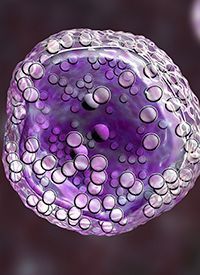Novel CRISPR Imaging Technology Reveals Genes Controlling Tumor Immunity
Next-generation spatial genomics technology paves the way for accelerating the discovery of new cancer drug targets

Mount Sinai scientists have developed a new technology allowing them to link specific genes to complex tumor characteristics at a scale and resolution not previously possible. The results could lead to new approaches for targeting anti-cancer drugs.
The technology, called Perturb-map, uses a novel genetic barcode system to mark cancer cells with different gene modifications and image the cancer cells, as well as neighboring non-cancer cells, within tissue. Using this approach, the researchers were able to identify specific genes controlling lung tumor growth, immune composition, and even response to immunotherapy, according to the study, published in the March issue of Cell.
Tumors are composed of many different cell types in addition to the cancer cells themselves, and over the past two decades, cancer treatment has been revolutionized by drugs that target the non-cancer cells in the tumor. These include immunotherapies such as Keytruda and Tecentriq, which turn on immune cells in the tumor and enable them to kill cancer cells, and Avastin, which alters the tumor’s blood vessels and starves the cancer.
Because the tumor’s environment has such a large effect on patient outcomes, there is a pressing need to find the genes used by cancers to control their local ecosystem. This information is key to developing new anti-cancer drugs. However, because tumors express hundreds of genes, finding the ones to target requires a scale of analysis that has been very difficult to achieve in animal models of cancer, which is necessary for faithfully representing the full cell ecosystem of a patient’s tumor.
Scientists have been using the gene editing technology called CRISPR for several years to knock out genes in cancer cells and study their function. Advances in DNA sequencing technology have made it possible to use thousands of CRISPRs at once so that every gene in the genome can be studied. However, these CRISPR genetic screens have only been able to identify genes and functions that operate within the cancer cells themselves. This has left many critical questions unanswered by genetic screens, such as how cancer cells alter the recruitment and activation of immune cells in the tumor, a key factor in patient response to immunotherapy.
Using Perturb-map, the scientists hit on two key pathways that had profound effects on tumor growth as well as tumor architecture and immune cell recruitment. One pathway was controlled by the cytokine interferon gamma (IFNg) and the other by the tumor growth factor beta receptor (TGFbR). They found that when the TGFbR2 gene or a gene coding for SOCS1, a regulator of IFNg, were deleted from the cancer cells, the lung tumors became larger and more abundant.
Although loss of either gene has a similar effect on tumor growth, imaging of the tumors, which was made possible by the Perturb-map platform, revealed that the SOCS1 tumors were highly infiltrated by T cells, while the TGFbR tumors excluded T cells. Even when SOCS1 and TGFbR tumors were in direct contact, the former remained infiltrated and the latter excluded. This is an important finding, as patients whose tumors contain fewer immune cells respond worse to immunotherapy drugs.
“These findings indicate that these genes’ effects over the tumor ecosystem are extremely localized,” said senior author Brian Brown, PhD, Director of the Icahn Genomics Institute and Associate Director of the Lipschultz Precision Immunology Institute (PrIISM) at Mount Sinai. “This is a notable insight because we are learning that many patient tumors are composed of genetically distinct subclones. If specific gene mutations are keeping T cells out of a subclonal region, this can serve as a pocket of resistance to immunotherapies like Keytruda. The local and distal effects of many other genes on tumor composition are still not known, but the Perturb-map platform will now give scientists a powerful means to tackle the problem”.
“Perturb-map is allowing us to identify the specific genes that control a tumor’s environment at a scale that wasn’t possible before. This includes making it possible to find the genes that are responsible for recruiting or reprogramming cells that prevent the immune system from eliminating tumors. It’s remarkable,” adds Miriam Merad, MD, PhD, a co-author of the study and the Director of PrIISM. “This is going to greatly enhance our ability to find new targets for better cancer therapies and that’s important for our patients.”



